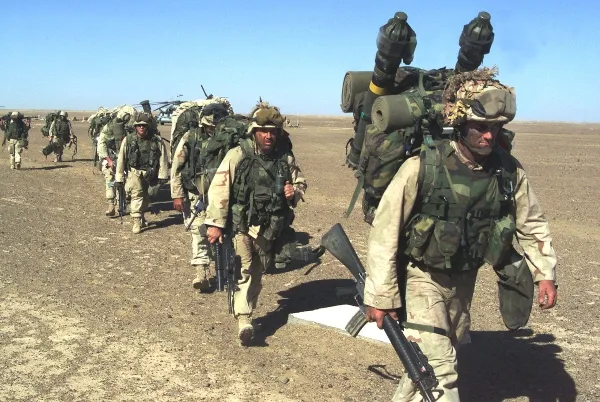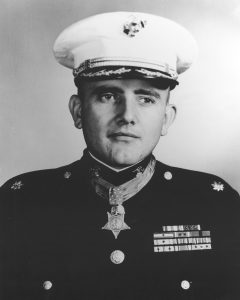
First things first – thank God that David Berger is no longer the Commandant of the United States Marine Corps. Where Douglas MacArthur failed to kill the Marine Corps back in the late 1940s, David Berger succeeded in the 2020s.
Here are just a handful of headlines of past articles I’ve posted of Berger doing everything in his power to destroy the Corps;
- Not Your Big Brother’s Marine Corps; Two MoH Winners Warn America that Current Commandant Committing ‘Irreparable Damage’ to Today’s Marine Corps
- (VIDEO) CENTCOM General Warns ISIS-K Can Hit America ‘Under Six Months’; Commandant of the Marine Corps Defends Woke Training
- The Death of the Corps; Commandant Fundamentally Changes the Entire Purpose of the Marine Corps
- Gutless Commandant of the Marine Corps; $2 Million University Recommends Dropping ‘Sir’ and ‘Ma’am’
With that aside, all this “Every Marine a rifleman” is bullshit. Every Marine may have to qualify with his service weapon on an annual basis as well as some half-assed “combat” test that lasts about an hour-and-a-half, but both are far from qualifying to be considered true riflemen. At least in the traditional sense.
I want to make something else crystal clear; I never held a Combat Arms MOS, although I did serve two tours with infantrymen.
Nonetheless, I was a REMF (Rear-Echelon Mother F***er). I went where the Marine Corps sent me and did the best job I could. Unfortunately for me, until I reached a certain rank was I free to train my Marines like I knew every Marine SHOULD train.
I will note that I was fortunate enough to know many decades ago Col. Carl Sitter, USMC (Retired) Medal of Honor. I was even more fortunate enough that he knew me by name, and we hoisted more than a few.
I remember him telling me of his actions in Korea where he earned the Medal of Honor.
Maybe he was being truthful, maybe he was just depreciating his own personal badassery, but he said that when first assigned to the FirstMarDiv, due to the glut of officers recalled for duty during the outbreak of the Korean War, he was assigned as the Division’s Recreation and Morale officer. I think he may have been pulling my leg just a wee bit.

Nevertheless, when the same FirstMarDiv slugged their way out of the Chosin Reservoir (surrounded by eight Communist Chinese divisions), it was then that then-Capt. Sitter was assigned as the Commanding Officer of George Company, 3/1 (Third Bn., 1st Marine Regiment).
As Col. Sitter told me, George Company was a strength of 156 Marines, only half of which were actually trained infantrymen. The other half were cooks, truck mechanics, and supply clerks and so on.
What Col. Sitter and George Co. did in taking on the ChiComs was to attack up-hill, in the snow, against a well-entrenched Chinese Communist regiment (3,000 soldiers)… and they won. As Col. Sitter would say, “We killed or captured half of them, the other half ran away.”
The good Colonel may not realize it, but he certainly re-enforced (in a big way) my belief that the units I had been assigned to in my short career didn’t deserve to carry the jockstraps of the so-called “support troops” who fought with Col. Sitter in that 48-hours of frozen hell that was just one of many the battles fought on one of the many ridgelines surrounding the Hagaru-ri Valley.
But getting back to my opinion that every Marine should be able to fight if and when designated/assigned to a provisional rife company.
If any given Marine Corps unit commander worth his salt wants to get back to being considered as true riflemen in the traditional sense, here’s a proposed readiness evaluation that EVERY Marine not assigned to a ground Combat MOS (infantry, LAV, recon, amtracks, etc) should be able to participate and complete on an annual basis.
Specifically, to include supply, administration, aircraft mechanics, cooks, etc. Literally all Force Support and Base personnel should be evaluated annually;
- Complete a 20-mile force march within eight hours or less.
- Each Marine WILL carry a 70-pound Assault Load (assigned weapon, extra ammunition, bayonet, food and water, helmet, body armor, extra boots and clothes, individual first-aid pack, etc.)
- Upon completion of the evaluation, 95 percent of each unit must have fully and completely completed the force march under their own power.
- Battalion and squadron commanders will ensure of 100 percent participation.
- Any Marine, regardless of rank, who has failed the evaluation will have all future promotions frozen. Those individuals who have transferred before a re-evaluation could be administered will carry their personal re-eval date with them their new duty station.
- Battalion and squadron commanders and Sgts. Majs. who fail to complete the training evolution with less than 95 percent completion rate of their particular commands will have their promotions frozen until the acceptable rate is met.
- Any individual Marine who fails the annual readiness evaluation twice consecutively will be discharged within three months with a ‘General under Honorable Conditions’ discharge and will not be subject to further evaluations.
- If any battalion or squadron commander to include their Sgts Majs, whose units fail to reach the 95 percent completion goal of the annual readiness evaluation twice consecutively will be relieved of duty for cause.
- Any Marine pending any ‘General under Other than Honorable Discharge’ or more severe are not subject to participation in the evaluation,
Other than support troops being literally fit to fight, this will ensure that when any given units fallout for PT (Physical Training), it won’t be in running shorts, running shoes, and a t-shirt for a measly three-mile run.
Who knows, this may lead to a whole new tradition of Support units regularly using their Fridays as six-to-12-mile marches instead of that patently worthless three-mile run in their skivvies.
Of course, I can hear all the “Everyone will have beaten-down and injured knees!”
I don’t care. I’d rather die in my bed as an old man with worn-out knees, than being killed on some faraway battlefield as a young dead man with perfectly healthy knees… but was never trained hard enough.
Throughout June, the USMC takes #Pride in re cognizing and honoring the contributions of our LGBTQ service members. We remain committed to fostering an environment free from discrimination, and defend the values of treating all equally, with dignity and respect.#PrideMonth #USMC pic.twitter.com/MOyvFmyJiB
— U.S. Marines (@USMC) June 1, 2022